Gas Turbine Technology
The source of Kawasaki Gas Turbines is here.

Kawasaki has developed advanced technologies to continuously improve the Kawasaki gas turbine line up.
These technologies have realized "Efficient Energy Use", "Eco-Friendly" and "Reliable Product Care for Total Life Cycle".
Low Emission Technology
Kawasaki gas turbines provide customers with clean energy for the purpose of global environmental protection.
Nitrogen oxides (NOx) contained in the exhaust gas are the cause of photochemical smog and acid rain. Kawasaki low emission combustion technologies dramatically reduce NOx in the exhaust gas, significantly reducing the environmental burden.
1) DLE Combustion Method
NOx is produced under high-temperature conditions during combustion*. With Kawasaki DLE (Dry Low Emission) combustion, world-class low NOx performance below 10ppm (O2=15%) is achieved by combining our own development of “Lean Premixed Combustion” and “Supplemental Combustion” systems.
The Kawasaki lean premixed combustion method evenly mixes the fuel with air prior combustion. This system greatly reduces NOx by achieving a uniform temperature distribution without causing local high temperature area.
The Kawasaki supplemental combustion method, a distinguishing feature of Kawasaki DLE combustor, adds fuel downstream from lean premixed combustion. Adjusting the amount of supplemental fuel controls the output while keeping the lean premixed combustion stable. As a result, the Nox emissions are stable and can be maintained at a low value.

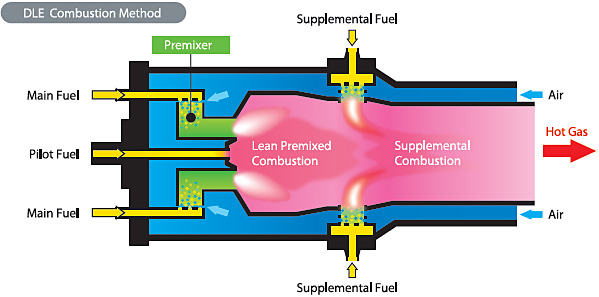
2) Steam/Water Injection Method
The Steam/Water Injection method is often used with Fuels that have a wider range of heating values or composition. The Steam/Water Injection method achieves low NOx levels combining steam/water injection with the ordinary diffusion combustion. With this conventional approach, combustion is carried out by directly injecting fuel into the combustor, without mixing it with air in advance. By injecting steam or water with the fuel, it is possible to reduce the combustion temperature, and lower the production of NOx emissions**.
*There are two types of NOx: The first one is Fuel NOx which is generated from nitrogen in fuel, and the second is Thermal NOx, which is generated when nitrogen in the air bonds with oxygen at high temperatures during combustion. Generally, fuel used in gas turbines has low nitrogen content, and thus thermal NOx is mainly mentioned. The DLE technology introduced in this column is effective for reducing thermal NOx caused by high temperature during combustion.
**The steam/water injection method used to be the main NOx reduction technology for gas turbines. The DLE combustion method has been devised as an alternative to this. The "dry" in the DLE (Dry Low Emission) implies no water is used, as opposed to the "wet" steam/water injection method in which water is used.
High Efficiency and Availability
Kawasaki is working to improve day-to-day performance and thereby boost customer profitability and protect the global environment.
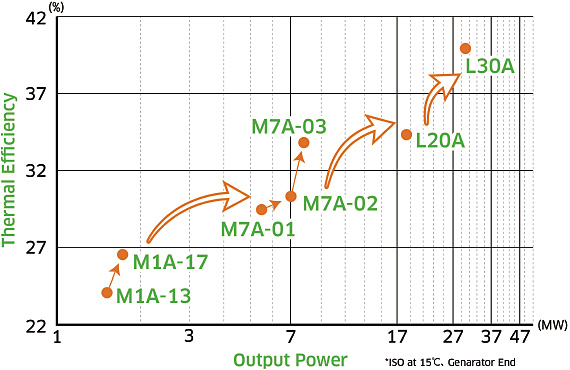
Development of Kawasaki Gas Turbine
History of Kawasaki Co-Generation Gas Turbines Development
1989: M1A-13, 1.5MW gas turbine.
1994: M7A-01, 6MW class gas turbine.
1998: M7A-02, 7MW class gas turbine by improving compressor of M7A-01 and increasing amount of air.
2001: L20A, 18MW class gas turbine, a scaled-up version of the M7A-02.
2007: M7A-03 gas turbine, the latest CFD, and improving element efficiency are applied.
2010:M1A-17, 1.7MW gas turbine, an upgraded version of the M1A-13.
2012: L30A, 30MW class gas turbine, a scaled-up version of the L20A.
Utilization of Advanced Technology
1) Fluid Analysis Technology
In recent years, improvement in computer performance has been remarkable and this has made it possible to perform more complex and large-scale analysis in the area of computational fluid dynamics (CFD). Kawasaki is optimizing the aerodynamic performance through multistage analysis of all stages of the compressor. Conjugate Heat Transfer Analysis is employed to simultaneously analyze the fluid flow heat transfer and blade material heat transfer.
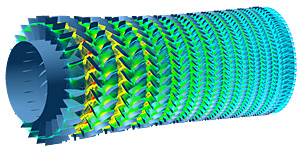
Analysis of All Stages of the Compressor
2) Technology of Higher Turbine Temperature
Increasing the turbine intake temperature (TIT) is effective for improving performance of the gas turbine. Higher TIT’s makes it essential to employ cooling technology to the internal blading and turbine materials. Kawasaki gas turbines aim to optimize cooling performance by applying the latest film cooling technology and Conjugate Heat Transfer analysis.
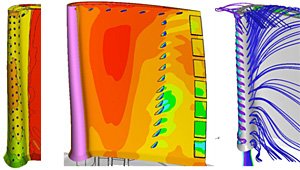
Conjugate Heat Transfer Analysis
Ref: ASME Turbo Expo 2012 GT2012-68679
Fuel Flexibility
Kawasaki gas turbines can run on a various range of fuel types.
In the past, applications of special fuels with characteristics such as low heating value have been very limited and such fuels have been thrown away instead of being effectively used. Kawasaki gas turbines can use various kinds of fuel in highly-efficient cogeneration systems, which contribute to global environmental preservation and a huge reduction of energy costs.
Kawasaki gas turbines can use hydrogen—the leading candidate as a next-generation clean fuel.
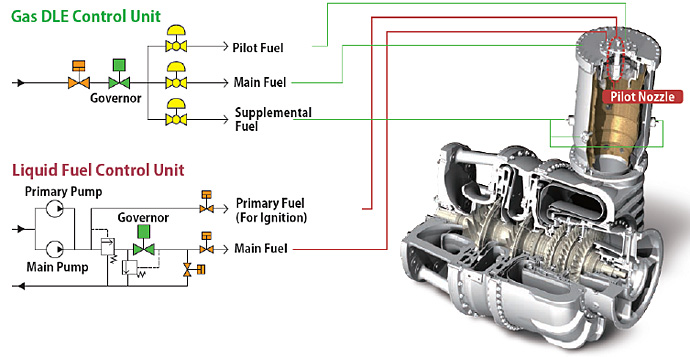
Dual fuel system which can be used
for both baseload and stand-by use
Dual Fuel combustion is available, in which the turbine can be operated by switching between two types of fuel.
The Duel Fuel “DLE + Liquid Standby Method”is often applied to co-generation and emergency double use generator sets. This method consists of using natural gas as the primary means of DLE combustion and liquid fuel for secondary, emergency situations. During ordinary conditions, the turbine operates with the DLE combustion method using gas fuel, thereby achieving low NOx and high efficiency. In case of an emergency with no gas supply, the gas turbine can start up on liquid fuel, or switchover from gas to liquid fuel so that power is supplied quickly and continuously.
Stable Power Supply
Kawasaki gas turbines are optimally-designed for power generation and can supply high-quality stable electricity even with large load variations. Kawasaki gas turbine can also handle intermittent operation that requires frequent start and stop in a short time frame.
Gas turbines can also contribute to stabilization of electric power supply by combining them with renewable energies, whose output often varies depending on the weather, by increasing or decreasing the load to suit changes in weather or stopping and restarting the turbine as needed.
Short Start Up Duration
Kawasaki is working to develop reliable gas turbine generator which provides power under various situations and restarting during coast down is one of the latest development.
Standby gas turbine generator used not to allow restarting during coasting to stop. Kawasaki has solved this problem and developed a new starting system which enables gas turbine generator to restart quickly before dropping to low shaft speed.
This new system has realized power supply within 40 seconds from a re-starting command even if it is under coast down process. Even in such situations in which start-and-stop repeats frequently and in a re-power failure just after the stop, Kawasaki gas turbine generator resumes power supply quickly.
This system best suites a pump station and important facilities such as data center, hospital which have to cope with the above situations respectively.
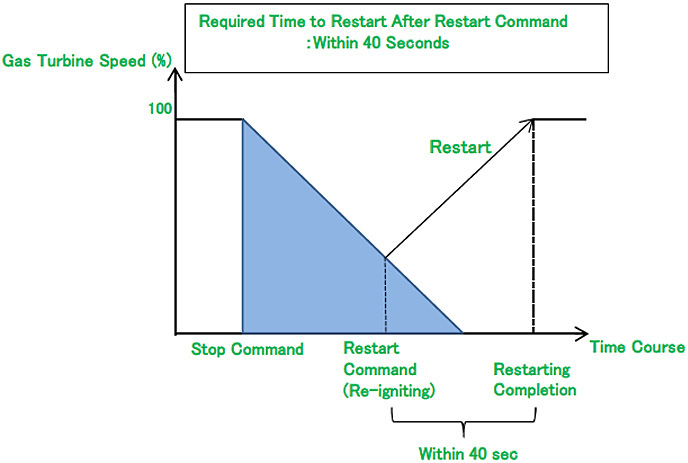
Links to Kawasaki Technical Review Reports
- Distributed Power Generation Systems That Meet Energy Needs
- Standby Gas Turbine Generator Set for Stable Supply of Electric Power
- Gas Turbine Cogeneration System for Energy Conservation and Better Power Supply Security
- Highly Efficient 30MW Class Gas Turbine, L30A
- Modification of 8MW Class Gas Turbine, M7A-03
- 1.7MW Class High Efficiency and Low Emission Gas Turbine, M1A-17
- DLE Combustion Technology for Enhancing the Environmental Performance
- Lean Methane- Fueled Gas Turbine Generator Set
- Gas Turbine Cogeneration System for Supercomputer "K"
Contact
If you need more information about our business,
please feel free to contact us.





